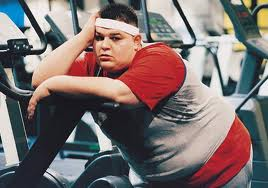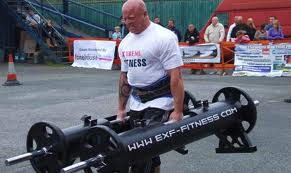
Cardio sucks! Seriously, traditional cardio is a waste of time, and I would probably be more productive trying to bend metal with my mind than I would be running in place on a treadmill. Now I know cardio has its benefits (it still has NO comparison to resistance training and conditioning), and if cardio is something you enjoy doing and it keeps you active and healthy, I support that 100 percent.
However, I would be lying if I said that I haven’t been looking for a reason to convince people to stop doing so much cardiovascular activity (not to be confused with conditioning such as sprints, jump rope intervals, farmer’s carries, etc.), and when it comes to the topic of losing body fat, I have found my opening. Cardio is a necessary component of a fat loss plan, and I would argue that the majority of people won’t be able to reach their fat loss goals without it. However, most people jump the gun and do WAY more cardio than is actually needed, and I feel this is the reason many of them never reach their ideal physique.
Cardio as a Fat Loss Tool
Generally speaking, cardio is implemented during a fat loss phase for two reasons:
- To create a caloric deficit
- To allow for an increase in dietary intake.
In order to lose body fat, we must be in a caloric deficit, and assuming that a properly designed resistance training program is in place, this deficit can be achieved by either reducing the amount of energy you are taking in (food), or increasing the amount of energy you are putting out (cardio).
It’s important to remember that throughout the fat loss phase, dietary intake must be kept HIGH enough to maintain good health and a high level of performance, and cardio must be kept LOW enough that it doesn’t interfere with recovery from training, or eat away at lean body mass. With that being said, fat loss is really just a balancing act between the two variables, with the goal of reaching your ideal physique while still meeting the before mentioned criteria.
Some people have a high enough metabolic rate that they can reach their fat loss goals with no cardio at all. I’m not one of them, and neither are the majority of people reading this article. For us, we will need to implement cardio at some point during the fat loss phase so that our food intake remains at a healthy level.
Now speaking of food, the second reason to implement cardio is simply so that you can eat more. Increase cardio (energy output), and you can increase food intake (energy input) while still reaching the deficit you’re shooting for. I mean lets face, who doesn’t like to eat, and being hungry all the time is a recipe for adherence disaster. When it comes time to pick between taking dietary intake extremely low, or throwing in some cardio so I can eat a little more, I will pick the higher food intake every time.
Why too Much Cardio is a Problem
The body is a survival machine that adapts to the stresses placed on it. I’m not going to get much into the science behind this, but just realize that an increase in cardiovascular activity is a stress, and therefore the body will adapt and become more efficient at performing the activity.
Whatever the amount of cardio you begin your diet with, whether it’s two days for 30 minutes or six days for 60 minutes, the body will adapt in a fairly short amount of time. Starting with two cardio sessions is no problem. You lose fat for a few weeks, hit a plateau, and can either add another day of cardio or increase the duration of a current session(s) to get the ball rolling again.
Starting with six sessions is a little different. You’re still going to lose weight for a few weeks (I say weight because not all of it is going to come directly from your fat stores), but once you hit a plateau (and it will hit far before you reach your goal physique), you’re really out of moves. Increase cardio anymore and you will hinder recovery and continue to eat away at lean body mass (a big no-no). You can decrease food intake, but eventually you will get to a point where reducing it any further will lead to malnutrition and a crashed metabolism.
And this is where people fall off. They realize that they can’t reduce food intake anymore, they can’t increase cardio (and the sight of the stair master makes them want to go ), so they just throw in the towel and give up. And that just starts a whole new host of problems. Remember that cardio is a tool for fat loss, but it’s not the only tool. Strength training and proper nutrition are much better options for this endeavor, and cardio should only be used when absolutely necessary.
HIIT or LISS
There are a lot of great articles covering which form of cardio is best for fat loss, so I am only going to touch on it briefly.
 HIIT (high intensity interval training) has the best effects on fat loss of any form of cardio. It burns a crap ton of calories in a very short amount of time, leads to a much greater post exercise caloric burn (you burn calories hours after the session is over), and stimulates the same muscle fibers used in resistance training, so it’s much better at helping you maintain muscle mass. However, it’s also extremely taxing on the central nervous system, and therefore can’t be used too frequently without interfering with your recovery and performance in the gym (which takes top priority).
HIIT (high intensity interval training) has the best effects on fat loss of any form of cardio. It burns a crap ton of calories in a very short amount of time, leads to a much greater post exercise caloric burn (you burn calories hours after the session is over), and stimulates the same muscle fibers used in resistance training, so it’s much better at helping you maintain muscle mass. However, it’s also extremely taxing on the central nervous system, and therefore can’t be used too frequently without interfering with your recovery and performance in the gym (which takes top priority).
In most cases, I don’t recommend going over 2-3 days of HIIT per week. If more cardio is needed to continue losing body fat, then that is where LISS comes in to play. Low intensity cardio can be used without having too much of an impact on recovery, and I would argue that it can actually enhance it because of increased blood flow. Obviously everything is situational, but HIIT and LISS both have a place in the overall fat loss plan.
How Much Cardio
Ideally, aim to keep cardio as LOW as possible that will keeping you progressing toward your fat loss goals.
For me, I like to start my caloric intake 200-300 calories below maintenance, and perform 1-2 days of cardio for about 30 minutes. Some people may not start with any cardio; others will start with a pretty decent amount. The time frame for reaching your fat loss goals, your current metabolic rate, current training program, etc. all come in to play when determining where you decide to start. Either way, take a minimalist approach, and only increase cardio when you absolutely need to.
Summing Up
One of my favorite quotes from T-nation editor Chris Shugart is that “cardio is for prey, and conditioning is for predators.” There is nothing inherently wrong with doing traditional cardio, but unless you are an endurance athlete, there are much better options for accomplishing your fat loss and physique goals. If you enjoy cardio (I can’t imagine who would), then go ahead and do it. Just realize that abusing it is dangerous, and if you are serious about building/revealing an impressive physique, you should prioritize resistance training and proper nutrition, and only use cardio as a last resort.

Like What You See?
Get the Smoot Fitness Guide to Getting Stronger - FREE.

Leave a Reply